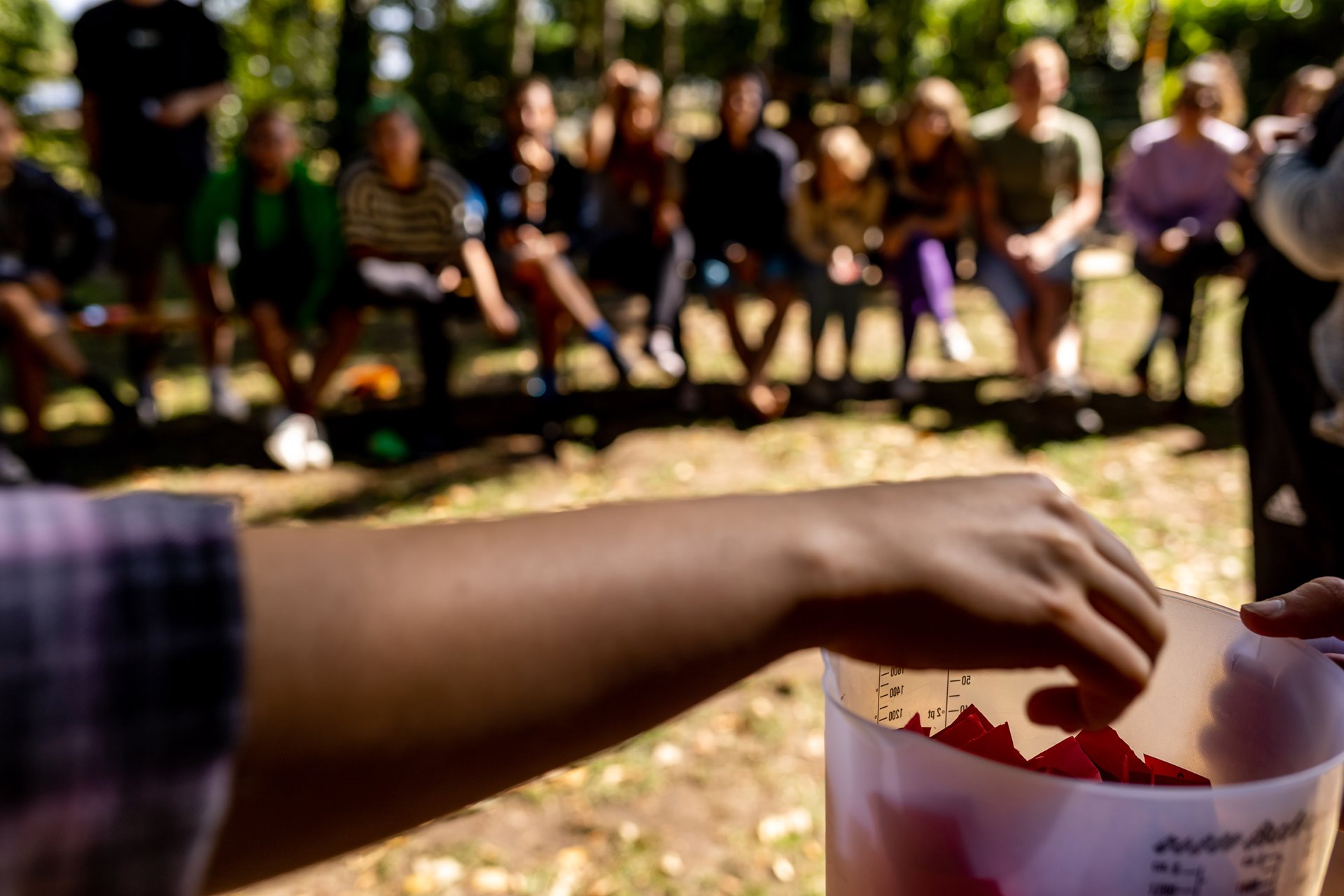JULIA WARDAKOWSKA
Out of your comfort zone
From the very first moments of the training, I realized that for some people going outside involves a physical representation of stepping out of their comfort zone and opening up to developing new skills. Fresh air, ubiquitous nature and high dependence on weather conditions evoke survivalism and tap into one’s primal instincts. But how can you view outdoor activities while being a facilitator? Outdoor:
- is associated with a larger space, the creative use of which is unlimited
- creates ideal conditions for developing cooperation skills in a group
- encourages you to set new challenges for yourself and others.
In this article, I want to show you how to explore each of the three points above in three different outdoor activities.

@laurlapaphotoghaphy
The sky is the limit
Let’s start with the creativity and space you have when organizing outdoor activities. One of my favorite types of activities that require both creativity and space are energizers – designed to ‘warm up the group before moving on to the main part of your workshop. This is an ideal opportunity to surprise the group and focus their attention on what you are to do together.
Take a small object in your hand. It can be a simple bottle, a cap, or anything you can find within your reach. Ask each participant to show you one hand, and one by one touch their hands with the object you are holding. You can make strange sounds while doing it, the idea is to make a show and mesmerize the group. Then place the object in the center of the circle you are forming and explain that this object has just done something unforgivable to the participants. The group’s task is to yell at the object as loudly as possible. One attempt is never enough 🙂
Organizing this energizer outdoors allows you to freely modify the size of the circle in which you stand and the volume of the shouting. It also reduces the likelihood of disturbing third parties. The sky is the limit, let your participants feel the reality of this expression.

@laurlapaphotoghaphy
Cooking in nature
An activity that can be done outdoors which serves to build team spirit and develop cooperation skills is… cooking together. I’m already explaining.
In this activity, the whole group has to prepare a meal for all participants, such as dinner, which takes about 2-3 hours (also depending on the size of the group). It involves dividing the group into 6 teams, each of which is responsible for one of the tasks: appetizer, main meat meal, vegetarian/vegan main meal, side dish, dessert, and atmosphere. The team in charge of the atmosphere does everything to make sure the rest of the group can work in the most pleasant conditions (provides background music, makes sure everyone has everything they need) and sets the table. In turn, the teams responsible for each part of the menu are given boxes of ingredients corresponding to their tasks, all of which are to be used. The cooking takes place outside. You can use a grill, campfire, or hiking stove for this.
The activity can, of course, be enriched. From the very beginning you can introduce elements of drama, e.g. “the kitchen exploded, we have to cook outside today” – you would say, your face painted with a black eye shadow, with a ladle in your hand. You can also make a race out of the activity, or make participants’ tasks more difficult by tying their hands together.
The very end of the activity is a magnificent meal in nature. Bringing together the entire menu prepared by several teams is very impressive and demonstrates how great results can be achieved by working as a team, in a good atmosphere, and with the right motivation.

@laurlapaphotoghaphy
City-village game
Organizing outdoor activities allows you to create an atmosphere in which participants are ready to take on new challenges, preferably the ones they set themselves. The activity I’ll introduce you to below fits in with the idea of “the participants choose themselves the experience that enriches them.”
A city-village game is an outdoor activity that is based on challenging yourself. It can take place anywhere, in the city, in the countryside, in the woods…
Divide your group into teams, deploy them away from each other, give them lists of tasks, set a time and place to meet again, and watch as your participants set challenges for themselves. It’s best if the tasks are funny and creative. My favorite examples are: “make fun of ducks”, “find 5 things that make you feel both awe and discomfort” or “show how to give advice to a squirrel”. Tasks in many cases should also leave plenty of room for interpretation of what “the author had on their mind”. It doesn’t matter how a participant or a team understands each task, what matters is that the extent to which they participate, is chosen by the participants themselves. They may not do some tasks, but they can do others surprisingly creatively. It is the participants themselves who choose the “how.”
Outdoor activities allow you to test yourself and your limits. In return, facing each challenge develops self-esteem – “if I handled this, I’m capable of doing anything”. In addition, the team nature of the activity provokes participants to think about their well-being as well as of the entire team and builds a sense of responsibility.

@laurlapaphotoghaphy
Change your surroundings
How do you envision your ideal training? Personally, since I discovered the outdoors, I feel like just grabbing a flipchart and sitting somewhere outdoors. If you are a facilitator accustomed to working mostly indoors, outdoor activities are certainly something that can enrich your workshops. Why not challenge yourself and change your surroundings 🙂
About the Author:
Julia Wardakowska
Beginning facilitator, student. She began her adventure with international youth exchange projects in 2019 and is currently active in the ESN UW student association. She loves working with people, traveling, and reading fantasy literature. Life motto? She doesn’t have one, preferring to have a new motto for each new day.
This article is the result of the „Wider Horizons” project, implemented by Development Support Foundation Innovator.
Project is co-financed by the European Union under Erasmus + Programme. (KA1 – Learning mobility of individuals, Mobility of adult education staff, Agreement No. 2020-1-PL01-KA104-079945).
This project has been funded with support from the European Commission. This publication reflects the views only of the author, and the Commission cannot be held responsible for any use which may be made of the information contained therein.
License CC BY-SA
BLOG Development Support Foundation Innovator is licensed under a Creative Commons Attribution-ShareAlike 4.0 License. We kindly ask you to quote the author of the entry explicitly and the source: “The text is from the blog of the Development Support Foundation Innovator and is located at [link to the relevant entry] Author of the text: [name surname]”.
The CC-BY-SA license is excluded from the logo of the Foundation, to which all rights are reserved.